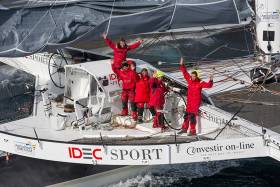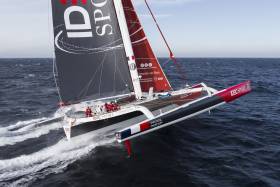Displaying items by tag: IDEC
The IDEC SPORT Maxi Trimaran Finishes in Record Time
The Maxi Trimaran IDEC SPORT sailed by Francis Joyon, Clément Surtel, Alex Pella, Bernard Stamm, Gwénolé Gahinet and Sébastien Audigane won the Jules Verne Trophy, the outright round the world sailing record, this morning.
They crossed the finish at 0749hrs UTC on Thursday 26th January 2017.
Francis Joyon and his crew sailed the 22,461 theoretical miles in 40 days, 23 hours, 30 minutes and 30 seconds, at an average speed of 22.84 knots.
Out on the water, they actually sailed 26,412 miles at an average speed of 26.85 knots.
They shattered the previous record set by Loïck Peyron and the crew of the maxi trimaran Banque Populaire V by 4 days, 14 hours, 12 minutes and 23 seconds.
During this round the world voyage, they smashed no fewer than six intermediate records at Cape Leeuwin, off Tasmania, on the International Date Line, at Cape Horn, at the Equator and off Ushant.
IDEC Sport : Full Speed Ahead To Ushant
200 miles south of the Azores, IDEC SPORT is starting the final stretch of her round the world voyage in favourable winds, which they have managed to pick up, getting the timing just right ahead of a front associated with a low-pressure system. With the speedo firmly stuck at thirty knots, Francis Joyon, Bernard Stamm, Alex Pella, Sebastien Audigane, Clement Surtel and Gwenole Gahinet are on the home strait at the pace they set in the Southern ocean, maintaining high speeds, while remaining vigilant as they face the elements. With 1300 miles to go to the finish, they are now expected on Thursday morning in Brest after forty days of racing against the clock, as they enter the final phase of the Jules Verne Trophy attempt.
The record to beat: 45 days, 13 hours, 42 minutes, 53 seconds.
"We're very lucky, as the weather is slotting into place. I think Francis must have spoken to the isobars," joked Bernard Stamm, who has every right to be pleased, with IDEC SPORT sailing smoothly on the North Atlantic swell under mainsail and gennaker in a 25-knot SSW'ly air stream. Approaching the Azores, everything is falling into place to allow them to continue to keep up the pace all the way to the coast of Brittany, as they sail practically on the direct route.
"We are entering a SW'ly air stream. It's more or less a straight line at full speed to Ushant in strong winds. It's up to us now to ensure we don't make any mistakes. We won't be putting our foot down like we did in the Indian. We want to preserve what we have built up, but it is great to finish at such high speeds. We're all remaining focused not to take excessive risks with the gear, which needs to work properly until the finish. We are remaining very upbeat about this incredible weather opportunity," added the Swiss skipper, who is about to finish his sixth round the world voyage.
Francis Joyon and the IDEC SPORT Team aboard the maxi-trimaran IDEC SPORT is about to achieve an incredible feat in the Jules Verne Trophy.
They are due to finish and cross the line off Ushant on Thursday 26th January 2017.
IDEC SPORT Halfway Round The World in Less Than 20 Days
The IDEC SPORT maxi-trimaran will this evening complete the first half of the round the world voyage. It will be around 1800hrs UTC that they will have sailed the 11,160 theoretical miles representing half of the total distance between Ushant and Ushant via the three major capes, Good Hope, Leeuwin and the Horn. Joyon and his men swallowed up this first half at an average speed of 24.2 knots. In reality they have sailed 13,200 miles out on the water, at the incredible average speed of 28.7 knots.
At the start of their nineteenth day of racing, as they approach New Zealand, this performance places them 1060 miles ahead of the title-holder of the Jules Verne Trophy, Banque Populaire V. As they begin to tackle the world's biggest ocean, the Pacific, there is a strange problem for Joyon and his band of soldiers. How can they slow down a boat that is eager to speed across the ocean? They need to look after the boat and there is the fear of going faster than the low-pressure system and ending up in calms. This today means that Joyon, Audigane, Pella, Surtel, Stamm and Gahinet are reining in their machine.
“We have set up a system rather like the points on your licence,” joked the Catalan Alex Pella. Tossed around by a nasty swell hitting the boat side on for the past 48 hours, Francis Joyon's crew have to put the brakes on their IDEC SPORT maxi-trimaran. “It is something of a paradox,” continued Francis. “We are trying to smash speed records, but in the past 48 hours, we have been trying to find ways to slow the boat down and look after her.” The unprecedented performance of the VPLP designed boat from 2005 must not stop us from thinking about the violence of the elements, which after 19 days, including eight at unprecedented speeds, has led to some breakages, albeit superficial ones. “The plexiglass screen at the helm did not resist a breaker,” explained almost matter of factly Francis Joyon. “We had to set up a replacement panel to protect the helmsman,” added Gwénolé Gahinet.
The nasty swell which was hitting the side of IDEC SPORT has now shifted to behind the boat. “Today, we have a very good wind angle with the breeze still at around thirty knots and the seas pushing us along from astern. The helmsman is not getting as wet and the movement of the boat is more comfortable than over the past couple of days,” stressed Francis. All lights are on green, in spite of the many little matters that the crew have to deal with and the start of the huge Pacific is a continuation at the same amazing speeds that they have been keeping up for nine days. “We are dreaming of Cape Horn, and the climb back up to Brazil,” said the youngest member of the crew, Gwénolé Gahinet. “A little bit of sunshine and warmth would do us good.” However getting to the Horn takes a lot of hard work. Francis Joyon thinks there will be a relative slowdown in the Pacific with a series of manoeuvres and gybes to weave in and out of the systems on the edge of the ice zone. This will be a welcome breather, allowing them to carry out a few repairs and inspect the boat.
A new intermediate reference time to Tasmania
After Leeuwin, just two days ago, it is the reference time from Ushant- Tasmania to the SE of Australia, which was smashed in the middle iof last night and taken away from Yann Guichard and Dona Bertarelli's Spindrift 2 maxi-trimaran by Joyon, Pella, Surtel, Gahinet, Stamm and Audigane. The new time is 18 days, 18 hours and 31 minutes replacing the previous time of 20 days, 4 hours and 37 minutes set last year by the world's biggest racing trimaran and a crew of fourteen.
French trimaran IDEC SPORT Hits 'UFO' 130 Miles off the Irish Coast
The massive French trimaran IDEC SPORT has hit an unidentified floating object during the night, 130 miles off the southwest coast of Ireland. The port rudder is broken. However they are still expected to reach the pontoon in Brest at 1900hrs UTC after its failed Jules Verne Trophy attempt.
At around 0300hrs this morning, just over 130 miles SW of Ireland in heavy seas, the crew on IDEC SPORT heard two big bangs, indicating that they had hit an unidentified floating object (a container, plank of wood, or something else?).
Once they had got over the scare, Francis Joyon’s crew saw that the port rudder was broken. On the starboard tack, only the central rudder can be used to steer the boat. Six hours after suffering this damage, IDEC SPORT was still making 30 knots towards the finish, which at 0900hrs this morning was 230 miles away. So for the time being the men are still expected to finish in Brest at around 1900hrs this evening.
Jules Verne Trophy Record Remains Intact But IDEC SPORT & Spindrift 2 Continue Race Against Clock
The Jules Verne Trophy record is not going to be beaten on this occasion. Small areas of low pressure and large highs spread across the Pacific and South Atlantic in particular, have dashed the hopes and ambitions of the two contenders, IDEC SPORT and Spindrift 2, in spite of their determination and hard work.
However, the sporting desire remainsto get the most out of both racing machines right up to the end of their global voyages. Aboard IDEC SPORT, after 43 days of intensive sailing, they have the same desire to sail the final 2700 miles of the theoretical route, as they had back on the first day, as they are determined to get the best time possible off Ushant.
































































